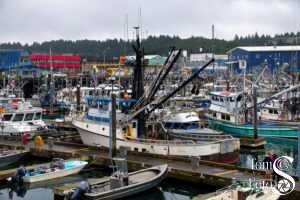Getting to Kodiak took a day at sea. Alaska is big and the islands stretch quite far toward Asia. The sea day was overcast all day with various times of heavy mist. The sea was angrier than it has been so far in the trip. The Pacific Princess would have been rocking and rolling; the Coral Princess also moved with the sea but not nearly so much. There is some benefit to a larger ship when it comes to riding out rougher water. So far, the largest “problem” with the larger ship has been the need to get to any event you want to attend anywhere from a half hour to an hour in advance in order to get a good seat.
We arrived in Kodiak on time. My walking excursion was scheduled for 10:30am. When I opened the cabin curtains I actually saw a very little piece of blue sky; it quickly disappeared and once more the day was overcast and at times a bit misty. The temperature, however, was a reasonable 50ish or so. Since Kodiak is an island the surrounding ocean tends to keep the weather there “mild” by Alaska standards. I dressed up in my Alaska outfit and went down to the meeting area for the excursions. There was a long line of folks wanting to leave the ship but as our 16 people were part of an excursion we got to buck the line and leave on time. The ship was docked about 1.5 miles from town and our excursion was a 1.5 mile walking tour…hmmmmm. You guessed it, we basically walked into town. As part of the walk and the major part of the tour our guide gave us a rather complete lecture on the fishing industry. Kodiak is one of the larger fishing ports in the world.
The guide was quite informative as I had a completely different view of fishing than actuality. For one thing, the captain and hands on a fishing boat work for free during the fishing itself. They are paid by share of the profit from the catch. So, if there is no catch, not only do they not get paid it turns out they will owe the owner of the boat their percentage of the cost of the fishing trip! The percentage might be as little as 0% for a trainee to around 10% for an experienced hand. Ten percent is also what the Captain gets. The owner, who has to pay for gas, maintenance, and other ship costs gets the rest.
It’s also interesting how they net and return the fish for processing; too detailed for this blog but it involves large vacuum hoses, circulating cooled sea water, ice slush, and other things. Catches are measured in the tons. Kodiak specializes in Salmon, Cod, Sea Slugs (I was told they are quite tasty), crabs, and Halibut. There are others as well but those were the most caught.
Most of the boats were in port as the salmon season is over and right now nobody has a hint where the halibut might be. With the sea warming some the entire fishing ecosystem is changing up here.
When we got to town we were turned loose to explore or either walk back or take a shuttle (school bus) back to the ship. I did a little exploring. The Russian influence shows up here as there is a small but quite nice Russian Orthodox Church with a blue domed roof right by the visitors’ center. Rode the shuttle back to the ship.
I and the team I play trivia with all made it back in time for the afternoon game which we won getting 19 out of 20 correct. This time the prize was a small notebook/journal.
We set sail about 5pm and are now heading in a general southwest course toward the northern part of Japan. Five days at sea for the transit (six calendar days but we drop one crossing the International Date Line). The next entry will depend on what happens in that time.
